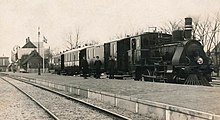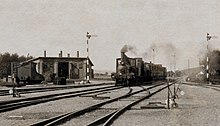Ryomgård station
| Ryomgård station | |
|---|---|
 Ryomgård Station (2019)
|
|
| Data | |
| Design | Through station formerly: branch station |
| Platform tracks | 2 |
| abbreviation | Rå |
| location | |
| City / municipality | Ryomgård |
| Country | Denmark |
| Coordinates | 56 ° 22 '48 " N , 10 ° 30' 2" E |
| List of train stations in Denmark | |
The Ryomgård station is located in the Danish town Ryomgård and is a station of Grenaabane that are part now of Aarhus Letbane is. For many years the station was Djursland's most important railway junction.
history
In 1873 it was decided to build a 64 km long railway line from Randers to Grenaa . The reason was that the long and narrow Randers Fjord often froze over in winter. Since there were no effective icebreakers yet, the port of the city was cut off from shipping for several winter months. The port of Grenaa, on the other hand, was mostly ice-free and an obvious destination for a railway.
At the same time, a railway line through Djursland should be an advantage for Randers' business life. This was observed with nervousness in Aarhus and it was agreed to build a 40 km long railway line from Aarhus to Ryomgård to the planned Grenaabane. The two lines were privately owned by Østjydske Jernbane (ØJJ). The cars were delivered by Scandia in Randers.
It was already known when the routes were built that they would unite in Ryomgård. Therefore, the station building was built larger than the other stations in Djursland. In addition to offices and post rooms, there was a restaurant in the station building. Ryomgård also received a warehouse and a double-track locomotive shed, which was located south of the main tracks. A water tower was erected at the western end of the main building. Since there was no electricity yet, the water was pumped into the tower by a pump driven by a wind turbine . Next to the water tower were two offices for the employees of the railway company.
There were only a few houses and a brick factory around the station when it opened. H. Mourier-Petersen, the owner of Gammel Ryomgård, refused to give land for residential use. Only a few more houses, a hostel and a dairy were built. Mourier-Petersen died in 1903, and the new landowner, Hofjagdmeister Holten Castenskjold, had a different attitude. More buildings and shops were built. The inn was expanded and renamed Elles Hotel (later Ryomgård Hotel).

Østjyske Jernbane (ØJJ)
Østjyske Jernbane opened the Randers – Ryomgård – Grenaa section on August 26, 1876 and the Aarhus – Ryomgård section on December 1, 1877. Three trains went in each direction every day. The company had a bad economic development from the beginning, so that both routes were taken over by Danske Statsbaner (DSB) in 1885 .
Ryomgård-Gjerrild-Grenaa Jernbane (RGGJ)
On December 5, 1911, the private railway line Ryomgård – Gjerrild (Gjerrildbanen) was opened, which was extended on June 27, 1917 from Gjerrild to Grenaa. The Gjerrildbane used the DSB station and had its own 100 m long platform on the main track, which led to a turntable.
To the east of the station building there were three tracks as well as the turntable with a diameter of 6½ m and a coal bane. This was followed by a 14 m long, single-track locomotive shed, in which there was a material room and an overnight room for the locomotive staff.
The station's water tower was not big enough to supply both the DSB and Gjerrildbane locomotives. Therefore, it was demolished in 1914 and replaced by a larger one that still exists and is the city's landmark.
Society struggled with losses for years. In 1956 the municipalities and the office agreed not to cover the deficit any further. With the company Pindstrup Mosebrug, director la Cour owned a branch in Stenvad , from which large quantities of peat and peat litter were sent by train. La Cour offered to operate the Ryomgård – Stenvad section on its own account, but there was no agreement with the liquidation committee. On June 30, 1956, the last train on the Ryomgård-Gjerrild-Grenaa Railway (RGGJ) departed from Ryomgård. The tracks were dismantled in the following months.
Danske Statsbaner (DSB)
By 1905, traffic grew to five pairs of trains in each direction every day. At times a reserve locomotive was stationed in Ryomgård. The double-track locomotive shed from 1876 was too small and stood in the way of expanding the track system. As a replacement, a new three-tier shed with a turntable in front of the building was built in 1908 at the western end of the station area.
A census in February 1911 showed that the lives of 45 people depended directly on the railroad.
A siding was built south of the main and loading tracks in 1913. The new company Andelsselskabet Kartoffeltørreriet was thus connected. In 1926 some buildings were converted for Dansk Andels Ægeksport . From 1959, the so-called Jiffy pots were produced in these buildings. These are pots that are used for planting, with the pot dissolving to allow the plant to grow freely. The siding has not been used and has been removed since the 1960s.
On May 2, 1971, passenger traffic on the Randers – Ryomgård railway was stopped. Freight traffic between Randers and Pindstrup remained until 1993. The Grenaabane from Aarhus to Grenaa was operated by the DSB alone until 2012 and together with the Odderbane as Aarhus Nærbane with through trains between Grenaa and Odder .
Aarhus Letbane
Aarhus Nærbane was closed on August 27, 2016 due to conversion to Aarhus Letbane . It was assumed that the Grenaabane would reopen in early 2018 as part of Aarhus Letbane. This reopening has been postponed indefinitely due to a security clearance. Approval was granted on April 25, 2019 and the reopening took place on April 30, 2019.
In connection with the renovation, the Syddjurs municipality decided to renovate the station and convert it into a terminal for buses and trams. The furnishings of the building were replaced and toilets were installed.
Djursland's Jernbane Museum
In 1981 the Djurslands Jernbane Museum was founded, which was initially housed in the former post rooms in the station building. Soon there was a lack of space for the many collectibles. That is why it acquired the former locomotive shed in 1995 with the support of the city administration, so that there was space for vehicles in addition to uniforms, photos, model trains and other collectibles. The museum has been a division of the Dansk Jernbane Club since 2007 .
Individual evidence
- ↑ Ole-Chr. Munk Plum: Midtjyske Jernbaner / Aarhus Nærbane . In: Jernbanen . No. 2016/5 , p. 18 .
- ↑ Aarhus Letbane åbner 23 September. Aarhus Letbane, April 28, 2017, accessed October 5, 2019 (Danish).
- ↑ Derfor bliver åbningen af Odder- og Grenaabanen forsinket. Aarhus Letbane, January 29, 2018, accessed October 5, 2019 (Danish).
- ↑ Letbanen åbner for passagerdrift til Grenaa April 30th. Aarhus Letbane, April 25, 2019, accessed October 5, 2019 (Danish).
- ↑ Flemming Nielsen, Sarah Friis Elkjær: Endelig ruller letbanen fra Djursland med de første passagerer. In: dr.dk. April 30, 2019, accessed October 5, 2019 (Danish).
- ↑ Nyhedsbrev # 35. Aarhus Letbane, December 13, 2018, accessed October 5, 2019 (Danish).
Web links
- Asger Christiansen: Djursland's Jernbane Museum. Ryomgård station - history. In: djbm.dk. (Danish).
literature
- Asger Christiansen: Gjerrildbanen - en rejse gennem Norddjurs . Ed .: Dansk Jernbane-Klub. No. 60 , 2017, ISBN 978-87-87050-14-2 , pp. 169-171 .



